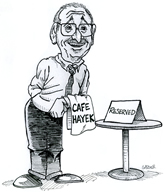For many businesses, that rearrangement of supply chains will mean that their costs will increase. If that occurs, their margins will be depressed, leaving them with less money to innovate, invest, hire, pay their workers, and reward their shareholders. Alternatively, they can offset those cost increases by passing them on, in whole or in part, to their customers. That won’t be an easy calculation. Hike the prices too much, and their customers, who may be under pressure due to other tariff-generated price increases, may go away. Hike the prices by too little, and the business takes a hit. And now, those businesses (or at least, I imagine, larger businesses) will have to contend with the fact that the FTC may be second-guessing their pricing decisions.
Even if those decisions are perfectly justifiable, being investigated by the FTC is (as the Biden administration knew and exploited) expensive and time-consuming, facts which will mean that businesses opt to increase their prices by less than they need, and pay for the hit to their margins by, say, hiring less and firing more. Alternatively, they may decide that a given product or line of business is no longer worth pursuing. That could mean layoffs, and if enough companies follow suit in the same areas, it could mean shortages. And what happens when there are shortages? Prices rise.
I find the public discussion of tariffs very convoluted and complex with the core considerations not understood.
1. All but minimum subsistence levels of wealth are created through individual choice in markets disciplined by opportunity costs.
2. As Adam Smith understood, wealth is created by input specialization (he called it the division of labor).
3. Specialization is limited by the extent of markets. Thus, the important consequence of globalization which has expanded markets and wealth creation.
4. Tariffs reduce market exchange and total wealth creation making people generally worse off.
Mr. Powell implied that the Fed may not ride to Mr. Trump’s rescue if the tariffs lead to economic stagflation. He said the Fed will continue with a cautious approach on interest rates, which makes sense given the two-sided risks of rising prices and slowing growth.
That appears to have set off Mr. Trump, who posted a broadside on Truth Social after Mr. Powell’s remarks: “This would be a PERFECT time for Fed Chairman Jerome Powell to cut Interest Rates. He is always ‘late,’ but he could now change his image, and quickly,” Mr. Trump wrote. “CUT INTEREST RATES, JEROME, AND STOP PLAYING POLITICS!”
Mr. Trump always favors lower interest rates no matter the economic facts. But his post suggests that he may be more worried than he admits about the impact of his tariffs on growth. He purports not to care about the markets these days, but you can bet he’s paying attention to them. The two-day decline of 10.5% in the S&P 500 since his Wednesday afternoon announcement isn’t a vote of confidence in Mr. Trump’s tariffs or policy judgment.
Friday’s plunge was spurred by China’s decision to retaliate with a 34% tariff of its own on U.S. exports, along with new restrictions on U.S. access to critical minerals. Mr. Trump responded by saying that CHINA PLAYED IT WRONG, THEY PANICKED.”
But what did he expect? China’s Xi Jinping has his own domestic constituencies to think about, and he wants Mr. Trump and the U.S. to feel the pain too. Treasury Secretary Scott Bessent urged countries not to retaliate lest they face even higher tariffs. But after China’s retaliation, that may be exactly what investors now fear as each leader beats his chest.
Paul Sracic makes clear that Trump’s tariffs are unconstitutional. Two slices:
President Trump relied on the International Emergency Economic Powers Act to impose last week’s reciprocal tariffs, some of which are as high as 49%. This expansion of executive authority clearly oversteps the boundaries set by the Supreme Court’s major questions doctrine. Prominent in recent judicial rulings, the doctrine holds that federal agencies—and the executive branch—can’t make decisions of vast economic and political significance without clear congressional authorization.
IEEPA, enacted in 1977, was intended to rein in what Congress considered overuse of the Trading with the Enemies Act. Under IEEPA, the president retained broad authority to regulate international economic transactions during a declared national emergency. The law’s purpose was to address genuine crises—like foreign aggression or economic sabotage—not to serve as a catch-all to implement domestic policy preferences. Mr. Trump’s reciprocal tariffs stretch IEEPA beyond its intended scope, sidestepping Congress’s constitutional authority over trade and taxation. This undermines the separation of powers and sets a dangerous precedent for unchecked executive overreach—precisely the problem the major questions doctrine seeks to remedy.
President Trump proclaims his tariffs will bring manufacturing jobs back to the U.S. Good luck finding workers to fill them. A common lament among employers, especially manufacturers, is they can’t find reliable, conscientious workers who can pass a drug test. Single women might commiserate: A good worker, like a good man, can be hard to find these days.
Blame government, which showers benefits on able-bodied people who don’t work while at the same time subsidizing college degrees that don’t lead to productive employment. The result is millions of idle men and millions of unfilled jobs—what an economist would call a deadweight loss to society.
Forty percent of small business owners in March reported job openings they couldn’t fill, with larger shares in construction (56%), transportation (53%) and manufacturing (47%), according to last week’s National Federation of Independent Business survey. The Labor Department’s Job Openings and Labor Turnover Survey of businesses tells a similar story. There are twice as many job openings in manufacturing than in the mid-2000s as a share of employment. Save for during the pandemic, America’s worker shortage is the worst in 50 years.
Decades ago, productivity-enhancing technology and, yes, inexpensive imports caused men who worked on shop floors to lose their jobs and drop out of the workforce. But this generation is sailing into the sunset, and there are many fewer young Americans who want to work in factories.
The Babylon Bee appropriately pokes fun at Tariff Man.
Ankith Reddy Madasani and Wesley Davenport expose “the costly illusion of protection.”
J.D. Tuccille urges the Trump administration to “focus on deregulation, not tariffs.”
For many years the government published a plethora of different balances. . . . In 1976, an advisory committee of prominent economists looked at these statistics, and was moved to wonder whether any of them meant anything. The committee suggested that “the words ‘surplus’ and ‘deficit’ be avoided insofar as possible.” For “these words are frequently taken to mean that the developments are ‘good’ or ‘bad’ respectively. Since that interpretation is often incorrect, the terms may be widely misunderstood and used in lieu of analysis.” Following the committee’s recommendations, the Commerce Department stopped publishing most of the balances. Because it had to publish something it kept the trade balance, which has been bedeviling us ever since. The “trade deficit” has been enthroned as a kind of economic black hole from which nothing escapes.
In fact, the United States ran a trade deficit in nearly all of its first 100 years, and ran surpluses in the midst of the Great Depression. A trade deficit is typical of rapidly growing economies, which require a disproportionate share of the world’s resources, and provide investment opportunities to balance the equation. Indeed, under the accounting identity, investment inflows must be balanced with a deficit on the trade account. The mystery is why we even collect these figures; if we kept similar statistics for Manhattan Island, Park Avenue could lay awake at night worrying about its trade deficit.
Alex Tabarrok lays out the clear economics of why tariffs cause domestic prices to rise.



